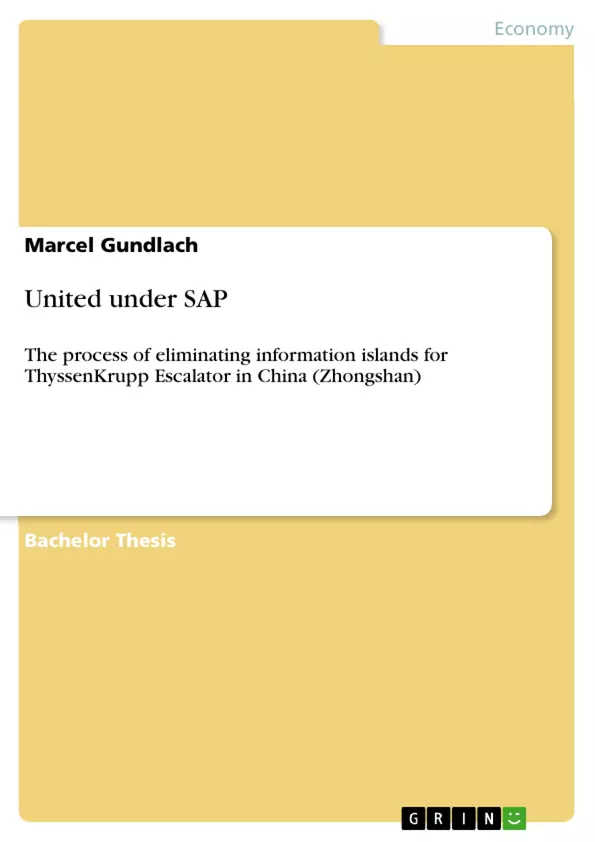Nowadays, companies all over the world face incredible pressure in global markets. To survive and to stay competitive, procurement of every description needs to be developed as a major leverage to save cost in the recent years. To achieve competitive differentiation with advantage, companies have to empower information workers. Business processes are the key to unlock the potential of these strategies.
A supportive IT structure may play a decisive role for business processes and can make a great deal of difference. The implementation of an ERP system provides an opportunity of a ‘‘configurable information system (IS) package that integrates information and information-based processes within and across-functional areas in an organization’’ . In information system areas, implementation is defined as ‘‘the process that begins with the managerial decision to install a computer-based [...]
Inhaltsverzeichnis (Table of Contents)
- 1 Introduction
- 1.1 Motivation
- 1.2 Objective
- 1.3 Thesis structure
- 2 Disambiguation
- 2.1 SAP System
- 2.1.1 SAP ERP w/ ECC 6.0
- 2.1.2 Accelerated SAP (ASAP)
- 2.2 Information
- 2.2.1 Information flow
- 2.2.2 Information island
- 3 Company introduction
- 3.1 ThyssenKrupp Group
- 3.2 ThyssenKrupp Elevator
- 3.2.1 Business Unit Structure
- 3.2.2 ThyssenKrupp in Zhongshan
- 4 Influence of Chinese Culture on the business company
- 4.1 Language and mindset
- 4.2 Corporate culture and Chinese work attitude
- 4.2.1 Systematic approach
- 4.2.2 Interpersonal relationships (Guanxi)
- 5 The process of implementation
- 5.1 Prearrangement
- 5.1.1 System Requirements
- 5.1.2 (Project) Management organization and requirements
- 5.2 Actual analysis (as is)
- 5.2.1 Business processes at present
- 5.2.2 Currently used applications and procedures
- 5.2.3 Current problems
- 5.3 Target Analysis (to be)
- 5.3.1 Project plan
- 5.3.2 Scheme of improvement
- 5.4 Realization of the project
- 5.4.1 Project Preparation
- 5.4.2 Blueprinting
- 5.4.3 Realization
- 5.4.4 Final Preparation
- 5.4.5 Go Live and Support
- 6 Reaches & Results
- 6.1 Project appraisal
- 6.1 Reaches in relation to the process of eliminating information islands
- 6.1.1 Disclosing information islands
- 6.1.2 Discovered existing information islands
- 6.1.3 Method of treatment
- 6.2 Comparison: "as is" – "to be"
- 6.3 Assets & Drawbacks
Zielsetzung und Themenschwerpunkte (Objectives and Key Themes)
This thesis examines the process of eliminating information islands at ThyssenKrupp Escalator in Zhongshan, China, using SAP. The main objective is to analyze the implementation of an SAP system and its impact on improving information flow within the company.
- Implementation of SAP systems in a multinational context.
- Impact of cultural differences (specifically Chinese culture) on project implementation.
- Analysis of existing information islands and their negative effects on business processes.
- Strategies for eliminating information islands through improved information flow.
- Evaluation of project success and identification of potential challenges.
Zusammenfassung der Kapitel (Chapter Summaries)
Chapter 1 introduces the thesis, outlining its motivation and structure. Chapter 2 defines key terms, including SAP systems and information islands. Chapter 3 provides background information on ThyssenKrupp and its operations in Zhongshan, China. Chapter 4 discusses the influence of Chinese culture on business practices. Chapter 5 details the implementation process, covering pre-planning, analysis of existing processes, target analysis, and realization of the project. The early part of Chapter 6 presents the results of the project appraisal, focusing on the identification and treatment of information islands.
Schlüsselwörter (Keywords)
SAP implementation, information islands, ThyssenKrupp, China, cultural influence, business process improvement, project management, information flow.
- Citar trabajo
- Marcel Gundlach (Autor), 2008, United under SAP, Múnich, GRIN Verlag, https://www.grin.com/document/123387



